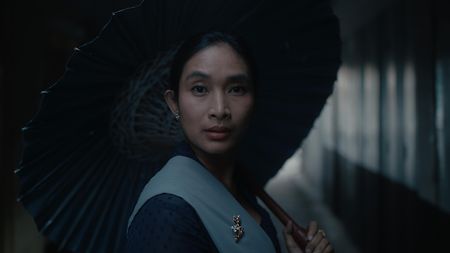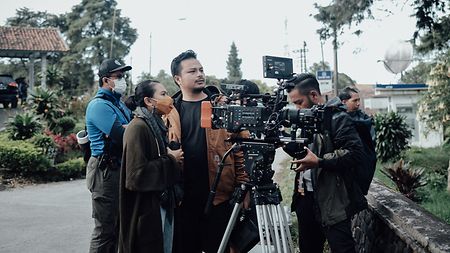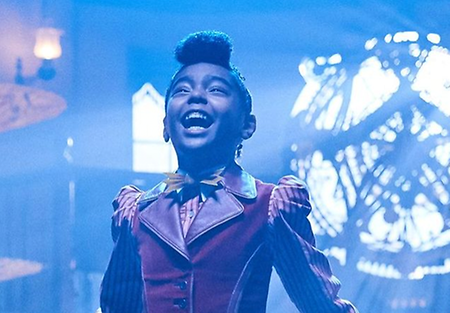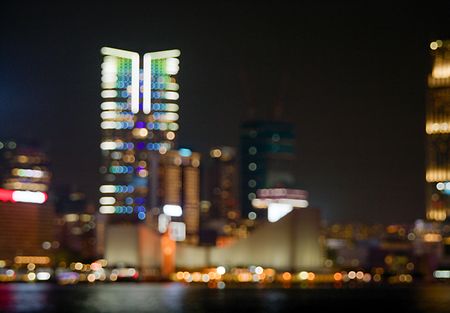A captivating story of a woman’s multifaceted struggles, “Before, Now & Then” has touched the hearts of local and global audiences alike. The film won Best Feature Length Film and Best Cinematography at the Festival Film Indonesia 2022. It also earned critical acclaim at the Berlin International Film Festival and, most recently, at Camerimage. This stunning period drama was the result of a close-knit collaboration between director Kamila Andini and DP Batara Goempar ICS.
“Before, Now, & Then” tells the story of Nana, who, years ago, escaped from an anti-communist purge in Indonesia, leaving her murdered father and presumably dead husband behind. In stark contrast to her past, the film features Nana living a comfortable life after remarrying a plantation owner. However, peace is still out of reach as her turbulent history constantly haunts her in her dreams.

A “Before, Now & Then” still of protagonist Nana
Unlike Goempar’s previous works, such as “Ali & Ratu Ratu Queens,” “Cadet 47,” and “Perfect Stranger,” this slow-burn narrative was uncharted waters for him. Nevertheless, he was eager to take on the challenge. “It’s a different genre for me, but I like it. It’s better when there is diversity, and we should embrace a variety of filmmaking in Indonesia,” the DP says.
Replaying how he and Andini planned the look, Goempar explains: “When I talked to Kamila, she wanted to add a certain coldness to the film, as if there’s always a void. At first, I suggested using desaturated colors as a theme, but she was adamant about still having a stylistic approach.”

An early scene from the film: Nana with Mr. Darga and Dais
“With this in mind, texture became a major element of the film. We have shots with, and sometimes behind, sheets of Vitrase (Indonesian translucent laced curtains). We added colors through the wardrobe and production design. In the end, despite being a lonely film, the visuals were filled with colors and textures, and this huge contrast added a lot of richness to the look,” the award-winning cinematographer continues.
Citing his favorite part of the film, Goempar chose one of the first scenes. “At the beginning of the film, there’s an excerpt of Nana going through her routine in the house. It sort of builds upon the narrative of how women should stay at home and follow a fixed set of household responsibilities. I love this scene because it subtly dictates how the entire film will proceed,” says Goempar. “We didn’t do a lot of dynamic camera movements, mainly static shots, but each cut, from scene to scene, was edited very carefully with utmost patience. Every shot was slow and cinematic.”

DP Batara Goempar with the ALEXA LF and Signature Primes behind the scenes
Another creative decision that was made early on was how the team would handle the dream or hallucination sequences. “The film is called ‘Before, Now & Then’ because it represents the complexities of a woman’s difficult past, present situation, and what she sees in her future. Usually, filmmakers would do separate tones to depict each period, but Kamila wanted the cinematography to merge. We wanted reality, hallucinations, and expectations to flow together naturally,” shares Goempar.
When asked about his choice of equipment, he exclaims: “Honestly, the only camera and lenses that can fulfill my shooting style are the ALEXA LF and ARRI Signature Primes. That’s the reason why I have been using them constantly for almost four years. They feel like home. Not to mention, it’s always a good investment for the producers to shoot large format for the future.”

DP Batara Goempar with director Kamila Andini shooting an outdoor scene
“I can always get more immersive images with the ALEXA LF and a softer look with Signature Primes. It feels like a magnifying glass. I can see up close and capture the actors’ emotions and nuances, but there is still a decent distance between us. Even in silence, you can see Nana’s expression and body language. Happy Salma, the actress who plays Nana, started in theatre, and she’s very expressive with her gestures,” Goempar adds.
As for the Signature Prime’s focal length, Goempar prefers to work with fewer lenses than most, limiting his choice to only the middle range, usually between 35 mm and 75 mm. “I’m not a fan of switching lenses too often,” he explains. As an audience, when you watch these types of films, you don’t want to be distracted by the frequent lens change. The main focus is not on the technical composition but on the story we want to tell.”
“Before, Now & Then” is streaming on Amazon Prime Video.


